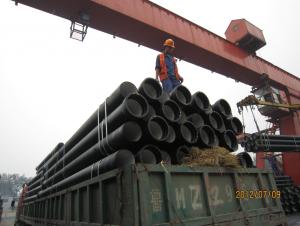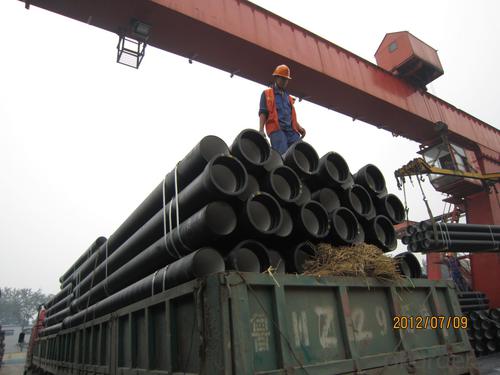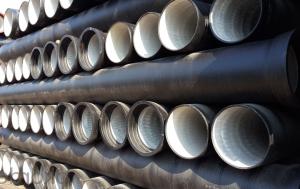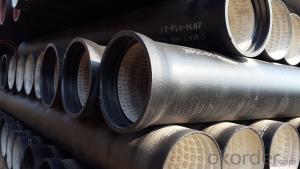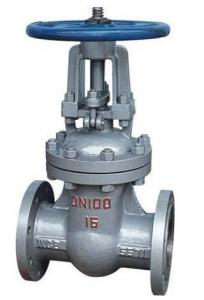Ductile Iron Pipe DN150
OKorder Service Pledge
OKorder Financial Service
You Might Also Like
Specifications
Quick Details
| Place of Origin: | China (Mainland) | Brand Name: | CMAX | Model Number: | T type / K type / Flange type |
| Length: | 6m / 5.7m / Negotiable | Standard: | ISO2531 / EN545 / EN598 | Application: | Potable / Sewage water |
| Diameter: | DN80~DN2200 | Shape: | Round | Hardness: | 230 |
| Pipe Wall Thickness: | standard | Pull Strength: | 420 | Yield (≥ MPa): | 300 |
| Material: | Ductile Iron | Type: | Centrifugal ductile cast iron pipe | Certification: | ISO2531 / EN545 / EN598 |
| Outer Diameter: | 80-2200 | Thickness: | standard | Specification: | DN80~DN2200 |
| |
The advantages to the customer:
Trustworthy financial strength.
One-stop shopping.
Fast and efficient service.
Coordination of shipments from multiple plants.
Specialists of the overseas shipping process.
A more competitive price.
Ductile iron pipe is sized according to a dimensionless term known as the Pipe Size or Nominal Diameter (known by its French abbreviation, DN). This is roughly equivalent to the pipe's internal diameter in inches or millimeters. However, it is the external diameter of the pipe that is kept constant between changes in wall thickness, in order to maintain compatibility in joints and fittings. Consequently the internal diameter varies, sometimes significantly, from its nominal size. Nominal pipe sizes vary from 3 inches up to 64 inches, in increments of at least 1 inch, in the USA.
Pipe dimensions are standardised to the mutually incompatible AWWA C151 (U.S. Customary Units) in the USA, ISO 2531 / EN 545/598 (metric) in Europe, and AS/NZS 2280 (metric) in Australia and New Zealand. Although both metric, European and Australian are not compatible and pipes of identical nominal diameters have quite different dimensions.
Flanges are flat rings around the end of pipes which mate with an equivalent flange from another pipe, the two being held together by bolts usually passed through holes drilled through the flanges. A deformable gasket, usually elastomeric, placed between raised faces on the mating flanges provides the seal. Flanges are designed to a large number of specifications that differ because of dimensional variations in pipes sizes and pressure requirements, and because of independent standards development. In the U.S. flanges are either threaded or welded onto the pipe. In the European market flanges are usually welded on to the pipe. In the U.S. flanges are available in a standard 125 lb. bolt pattern as well as a 250 lb (and heavier) bolt pattern (steel bolt pattern). Both are usually rated at 250 psi (1,700 kPa). A flanged joint is rigid and can bear both tension and compression as well as a limited degree of shear and bending. It also can be dismantled after assembly. Due to the rigid nature of the joint and the risk of excessive bending moment being imposed, it is advised that flanged pipework is not buried.
Current flange standards used in the water industry are ANSI B16.1 in the USA, EN 1092 in Europe, and AS/NZS 4087 in Australia and New Zealand.
Ductile iron pipe is somewhat resistant to internal corrosion in potable water and less aggressive forms of sewage. However, even where pipe material loss and consequently pipe wall reduction is slow, the deposition of corrosion products on the internal pipe wall can reduce the effective internal diameter. A variety of linings are available to reduce or eliminate corrosion, including cement mortar, polyurethane and polyethylene. Of these, cement mortar lining is by far the most common.
Polyurethane (Plastic wrap) marginally protects piping made of ductile cast iron against corrosion and ensures meeting hygienic standards for drinking water at the same time in the early years. Polyurethane is used for both the inside lining and the outside coating. Because of polyurethane's elasticity, the coating remains intact even if the pipe is deformed. A major problem is that the poly wrap is not able to be uniformly installed or even installed without rips and creates isolated corrosion attacks. Corrosion Experts
Polyurethane coatings were first used in 1972.[citation needed] In comparison with other coatings, the internal polyurethane lining exhibits a high resistance to various different media such as drinking water, wastewater, de-mineralised water, industrial water and gas, as well as to aggressive solutions such as sulphuric acid. The polyurethane outside coating is suitable for all kinds of soil.
Polyurethane is a thermosetting plastic with no solvents, with a three-dimensionally linked molecular structure giving it mechanical stability. The polyurethane used for conating has the following standard properties, according to EN 545 and ISO 2531 standards.
- Q: Can ductile iron pipes be used for underground fuel storage systems?
- No, ductile iron pipes are not suitable for underground fuel storage systems. They are more commonly used for water and sewer applications due to their strength and durability in carrying liquids. Underground fuel storage systems require materials that are specifically designed to handle the corrosive nature of fuel and prevent leaks or contamination, such as double-walled fiberglass or steel tanks.
- Q: How does ductile iron pipe perform in high-temperature environments?
- Ductile iron pipe performs exceptionally well in high-temperature environments due to its unique properties and characteristics. The material is known for its high strength, toughness, and durability, making it suitable for various applications including those involving elevated temperatures. One of the key advantages of ductile iron pipe in high-temperature environments is its ability to withstand thermal expansion and contraction. The material has a low coefficient of thermal expansion, which means it can handle significant temperature fluctuations without experiencing detrimental effects. This property ensures that the pipe remains structurally stable and does not deform or crack when exposed to high temperatures. Additionally, ductile iron pipe has excellent thermal conductivity. This property allows the pipe to efficiently transfer heat, preventing the build-up of excessive heat and reducing the risk of thermal stress. The high thermal conductivity of ductile iron also enables it to dissipate heat quickly, ensuring that the pipe remains within safe operating temperatures. Furthermore, ductile iron pipe has a high melting point, typically around 2200°F (1200°C). This characteristic ensures that the pipe retains its structural integrity even in extremely high-temperature environments. It can effectively handle hot fluids, steam, and other high-temperature substances without compromising its performance. Another crucial aspect is the corrosion resistance of ductile iron pipe. It is commonly coated with protective linings, such as cement mortar or epoxy, which provide an additional layer of defense against corrosion caused by high temperatures. These linings act as a barrier, preventing the pipe from coming into direct contact with corrosive substances and maintaining its longevity in high-temperature environments. In summary, ductile iron pipe is an excellent choice for high-temperature environments due to its exceptional strength, thermal stability, thermal conductivity, and corrosion resistance. Its ability to withstand thermal expansion, its high melting point, and its efficient heat transfer properties make it a reliable and durable option for various applications in such conditions.
- Q: The difference between ductile cast iron pipe and machine-made cast iron pipe
- Production process is different, ductile iron pipe mainly through intermediate frequency furnace heating, annealing, and then do cement lining cement lining production, the mechanism of cast iron pipe does not make cement lining.
- Q: What is the relationship between continuous cast iron pipe and ductile iron pipe?
- Cast iron pipes are divided into continuous cast iron pipes and centrifugal cast iron pipes according to different casting methods. They are divided into gray cast iron pipes and ductile iron pipes according to different materials.
- Q: How does ductile iron pipe perform in seismic areas?
- Ductile iron pipe performs exceptionally well in seismic areas due to its inherent strength and flexibility. Seismic activity can subject pipelines to significant ground movements and vibrations, and ductile iron pipes have proven to be highly resilient in such conditions. The unique properties of ductile iron, including its high tensile strength and ductility, allow it to absorb the energy generated during seismic events. This ability to flex and bend without breaking or fracturing makes it an excellent choice for areas prone to earthquakes. Furthermore, ductile iron pipes are designed and manufactured to withstand external forces and ground movements. They are often installed with flexible joints that can accommodate ground shifts and maintain the integrity of the pipeline system. These joints can absorb lateral and angular movements, reducing the risk of pipe failure. Additionally, ductile iron pipes have a long history of successful performance in seismic areas. They have been extensively tested and proven to meet or exceed industry standards for seismic resistance. This reliability is crucial in ensuring the safety and functionality of water and wastewater systems, even in the event of a seismic event. Overall, ductile iron pipe is a reliable and durable choice for pipelines in seismic areas. Its ability to withstand ground movements, its flexibility, and its proven track record make it an excellent option for ensuring the integrity and functionality of water and wastewater systems in earthquake-prone regions.
- Q: What are the typical surge anticipation measures for ductile iron pipe?
- Some typical surge anticipation measures for ductile iron pipe include using surge tanks or pressure relief valves, installing air release valves and surge suppressors, using flexible joint connections, and designing the pipeline with appropriate wall thickness and reinforcement.
- Q: How are ductile iron pipes repaired in case of damage?
- Due to their high durability and strength, ductile iron pipes are commonly utilized in various applications. However, like any other materials, these pipes can sustain damage over time due to external influences or internal corrosion. In such instances, there exist several techniques available for repairing ductile iron pipes. One prevalent method is the trenchless repair technique, which allows for the restoration of the damaged section without the need for extensive excavation. This method typically employs specialized equipment to access and repair the affected area. Its advantages lie in minimizing disruption to the surrounding environment and reducing excavation costs. Another approach for repairing ductile iron pipes involves the application of epoxy lining. This process entails the use of epoxy resin to seal any cracks or leaks on the interior surface of the pipe. Epoxy lining is a cost-efficient and effective solution as it provides long-lasting repairs and enhances the overall condition of the pipe. In cases where the damage is severe or extensive, it may be necessary to replace the damaged section of the ductile iron pipe. This typically involves removing the compromised portion and installing a new pipe section. The replacement process may require excavation and can be more time-consuming and costly compared to other repair methods. Nonetheless, it guarantees a comprehensive and permanent solution for the damaged pipe. It is essential to note that the choice of repair method for ductile iron pipes depends on factors such as the extent of the damage and accessibility. Professional assessment and inspection play a crucial role in determining the most suitable repair technique. Consulting experienced pipeline repair specialists or civil engineers is highly recommended to ensure the most effective and durable repair solution for ductile iron pipes.
- Q: How does the white iron appear in the case of ductile iron?
- If it is to solve the white cast, the casting can be annealed.To prevent a chill in the casting, it is important to know your entire casting process to find the cause and the solution.
- Q: Can ductile iron pipes be used for geothermal heating and cooling systems?
- Yes, ductile iron pipes can be used for geothermal heating and cooling systems. Ductile iron pipes are known for their strength and durability, making them suitable for underground applications like geothermal systems. They can withstand the high temperatures and pressure variations associated with geothermal heating and cooling, making them a reliable choice for this purpose.
- Q: Can ductile iron pipes be used for bridge crossings?
- Ductile iron pipes are indeed suitable for bridge crossings. This material is widely used in various applications, such as water and wastewater systems, due to its strength and durability. When it comes to bridge crossings, ductile iron pipes offer numerous advantages. They possess high tensile strength, enabling them to handle the load and stress imposed by the bridge structure. In addition, they are highly resistant to corrosion, making them well-suited for environments where bridges may be exposed to moisture and other harsh conditions. Moreover, ductile iron pipes have the capability to withstand seismic activity, making them a dependable choice for areas prone to earthquakes. Overall, ductile iron pipes are a reliable and appropriate option for bridge crossings due to their strength, durability, resistance to corrosion, and ability to withstand seismic activity.
Send your message to us
Ductile Iron Pipe DN150
OKorder Service Pledge
OKorder Financial Service
Similar products
Hot products
Hot Searches
Related keywords
